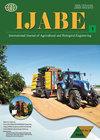Optimizing water-saving irrigation schemes for rice (Oryza sativa L.) using DSSAT-CERES-Rice model
IF 2.2
2区 农林科学
Q2 AGRICULTURAL ENGINEERING
International Journal of Agricultural and Biological Engineering
Pub Date : 2023-01-01
DOI:10.25165/j.ijabe.20231602.7361
引用次数: 0
Abstract
: Rice is one of the major crops in China, and enhancing the rice yield and water use efficiency is critical to ensuring food security in China. Determining how to optimize a scientific and efficient irrigation and drainage scheme by combining existing technology is currently a hot topic. Crop growth models can be used to assess actual or proposed water management regimes intended to increase water use efficiency and mitigate water shortages. In this study, a CERES-Rice model was calibrated and validated using a two-year field experiment. Four irrigation and drainage treatments were designed for the experiment: alternate wetting and drying (AWD), controlled drainage (CD), controlled irrigation and drainage for a low water level (CID1), and controlled irrigation and drainage for a high water level (CID2). According to the indicators normalized root mean square error (NRMSE) and index of agreement ( d ), the calibrated CERES-Rice model accurately predicted grain yield (NRMSE=6.67%, d =0.77), , shoot biomass (NRMSE=3.37%, d =0.77), actual evapotranspiration ( ET a ) (NRMSE=3.83%, d =0.74), irrigation volume (NRMSE=15.56%, d =0.94), and leaf area index (NRMSE=9.69%, d =0.98) over 2 a. The calibrated model was subsequently used to evaluate rice production in response to the four treatments (AWD, CD, CID1, and CID2) under 60 meteorological scenarios which were divided into wet years (22 a), normal years (16 a), and dry years (22 a). Results showed that the yield of AWD was the largest among four treatments in different hydrological years. Relative to that of AWD, the yield of CD, CID1, and CID2 were respectively reduced by 5.7%, 2.6%, 8.7% in wet years, 9.2%, 2.3%, 8.6% in normal years, and 9.2%, 3.8%, 3.9% in dry years. However, rainwater use efficiency and irrigation water use efficiency were the greatest for CID2 in different hydrological years. The entropy-weighting TOPSIS model was used to optimize the four water-saving irrigation schemes in terms of water-saving, labor-saving and high-yield, based on the simulation results of the CERES-Rice model in the past 60 a. These results showed that CID1 and AWD were optimal in the wet years, CID1 and CID2 were optimal in the normal and dry years. These results may provide a strong scientific basis for the optimization of water-saving irrigation technology for rice.基于DSSAT-CERES-Rice模型的水稻节水灌溉方案优化
水稻是中国的主要作物之一,提高水稻产量和水分利用效率对确保中国的粮食安全至关重要。如何结合现有技术优化科学高效的排灌方案是当前研究的热点问题。作物生长模型可用于评估旨在提高用水效率和缓解水资源短缺的实际或拟议的水资源管理制度。在这项研究中,CERES-Rice模型通过为期两年的田间试验进行了校准和验证。试验设计4种灌排处理:干湿交替(AWD)、控制排水(CD)、低水位控制灌排(CID1)和高水位控制灌排(CID2)。根据归一化均方根误差(NRMSE)和一致性指数(d),校正后的CERES-Rice模型准确预测了2 a内的籽粒产量(NRMSE=6.67%, d =0.77)、茎部生物量(NRMSE=3.37%, d =0.77)、实际蒸散量(ET a) (NRMSE=3.83%, d =0.74)、灌水量(NRMSE=15.56%, d =0.94)和叶面积指数(NRMSE=9.69%, d =0.98)。CID1和CID2)在60个气象情景下,分为湿润年(22 a)、正常年(16 a)和干旱年(22 a)。结果表明,在不同水文年的4个处理中,AWD产量最大。与AWD相比,CD、CID1和CID2的产量在丰水年分别降低5.7%、2.6%、8.7%,在平水年分别降低9.2%、2.3%、8.6%,在干旱年分别降低9.2%、3.8%、3.9%。但不同水文年CID2的雨水利用效率和灌溉水利用效率均最高。以CERES-Rice模型近60 a的模拟结果为基础,利用熵权TOPSIS模型对4种节水灌溉方案在节水、省力和高产方面进行优化。结果表明,CID1和AWD方案在丰水年最优,CID1和CID2方案在丰水年和干旱年最优。研究结果可为优化水稻节水灌溉技术提供有力的科学依据。
本文章由计算机程序翻译,如有差异,请以英文原文为准。
求助全文
约1分钟内获得全文
求助全文
来源期刊

International Journal of Agricultural and Biological Engineering
AGRICULTURAL ENGINEERING-
CiteScore
4.30
自引率
12.50%
发文量
88
审稿时长
24 weeks
期刊介绍:
International Journal of Agricultural and Biological Engineering (IJABE, https://www.ijabe.org) is a peer reviewed open access international journal. IJABE, started in 2008, is a joint publication co-sponsored by US-based Association of Agricultural, Biological and Food Engineers (AOCABFE) and China-based Chinese Society of Agricultural Engineering (CSAE). The ISSN 1934-6344 and eISSN 1934-6352 numbers for both print and online IJABE have been registered in US. Now, Int. J. Agric. & Biol. Eng (IJABE) is published in both online and print version by Chinese Academy of Agricultural Engineering.
 求助内容:
求助内容: 应助结果提醒方式:
应助结果提醒方式:


